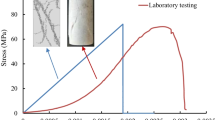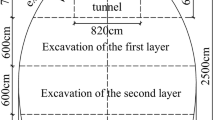Abstract
The seepage-damage coupling effect will aggravate the instability of the surrounding rock during the unloading process of underground cavern excavation. Considering this coupling effect and excavation disturbance, the theoretical solution of the stress state of surrounding rock is derived by using the elastic-brittle damage model. The dynamic criterion of the instability and water inrush is presented. Based on the theoretical derivation, the calculation program for the seepage-damage analysis of the surrounding rock under dynamic unloading is programmed, and the seepage flow and the radius of the damage zone of the surrounding rock are calculated. By analysing the variation of radius of the damaged zone with pore water pressure and excavation radius under different calculation conditions, the influence of dynamic unloading disturbance on the damaged zone of the surrounding rock is discussed. The radius of the damaged zone increases with the pore water pressure and excavation radius. Considering the effect of dynamic unloading, the calculation result of the damaged zone radius and seepage discharge of underground cavern are much larger than the theoretical calculation and coupling calculation of seepage-damage without dynamic unloading. Research methods and results can provide guidance and reference for similar engineering research.
Similar content being viewed by others
References
Bruno MS, Nakagawa FM (1991) Pore pressure influence on tensile fracture propagation in sedimentary rock. International Journal of Rock Mechanics and Mining Sciences 29(4):261–273, DOI: https://doi.org/10.1016/0148-9062(91)90593-B
Carollo V, Reinoso J, Paggi M (2017) A 3D finite strain model for intralayer and interlayer crack simulation coupling the phase field approach and cohesive zone model. Composite Structures 182:636–651, DOI: https://doi.org/10.1016/j.compstruct.2017.08.095
Crouch SL (1972) A note on post-failure stress-strain path dependence in norite. International Journal of Rock Mechanics & Mining Sciences & Geomechanics Abstracts 29(2):197–204, DOI: https://doi.org/10.1016/0148-9062(72)90022-8
Detournay E, McLennnan JD, Roegiers JC (1986) Poroelastic concepts explain some of the hydraulic fracturing mechanisms. SPE unconventional gas technology symposium, May 18–21, Louisville, KY, USA, DOI: 10.2118/15262-MS
Fattahi H, Shojaee S, Farsangi MAE, Mansouri H (2013) Hybrid Monte Carlo simulation and ANFIS-subtractive clustering method for reliability analysis of the excavation damaged zone in underground spaces. Computers and Geotechnics 29(10):210–221, DOI: https://doi.org/10.1016/j.compgeo.2013.07.010
Geertsma J (1985) Some rock-mechanical aspects of oil and gas well completions. Society of Petroleum Engineers Journal 29(6):848–856, DOI: 10.2118/8073-PA
Griffiths DV, Lane PA (1999) Slope stability analysis by finite elements. Geotechnique 29(3):387–403, DOI: https://doi.org/10.1680/geot.1999.49.3.387
Gu JC, Gu LY, Chen AM, Xu JM, Chen W (2008) Model test study on mechanism of layered fracture with in surrounding rock of tunnels in deep stratum. Chinese Journal of Rock Mechanics and Engineering 29(3):433–438, DOI: https://doi.org/10.3321/j.issn:1000-6915.2008.03.001 (in Chinese)
Lau JSO, Chandler NA (2004) Inovatove laboratory testing. International Journal of Rock Mechanics and Mining Science 29(8):1427–1445, DOI: https://doi.org/10.1016/j.ijrmms.2004.09.008
Li X, Cao W, Zhou Z, Zou Y (2014) Influence of stress path on excavation unloading response. Tunnelling and Underground Space Technology 42:237–246, DOI: https://doi.org/10.1016/j.tust.2014.03.002
Li LP, Chen DY, Li SC, Shi SS, Zhang MG, Liu HL (2017) Numerical analysis and fluid-solid coupling model test of filling-type fracture water inrush and mud gush. Geomechanics and Engineering 13(6): 1011–1025, DOI: https://doi.org/10.12989/gae.2017.13.6.1011
Li SC, Gao CL, Zhou ZQ, Li LP, Wang MX, Yuan YC, Wang J (2019) Analysis on the precursor information of water inrush in karst tunnels: A true triaxial model test study. Rock Mechanics and Rock Engineering 52:373–384, DOI: https://doi.org/10.1007/s00603-018-1582-2
Li LP, Li SC, Shi SS (2012) Multi-field coupling mechanism of seepage damage for the water inrush channel formation process of coal mine. Journal of Mining & Safety Engineering 29(2):232–238, DOI: https://doi.org/10.3969/j.issn.1673-3363.2012.02.015 (in Chinese)
Li ZH, Pan YS (2002) Analytical analysis of wellbore wall stability with seepage. Engineering Mechanics 29(3):105–108 (in Chinese)
Li SC, Zhou ZQ, Li LP, Xu ZH, Zhang QQ, Shi SS (2013) Risk assessment of water inrush in karst tunnels based on attribute synthetic evaluation system. Tunnelling and Underground Space Technology 38:50–58, DOI: https://doi.org/10.1016/j.tust.2013.05.001
Liang JW, He YA (1995) An effective criteria for dynamic instability of structures. Engineering Mechanics 29(1):53–57 (in Chinese)
Liu X, Lin Y, Kong J (2007) Study of hydro-mechanical coupling of fractured rock masses considering unloading effect. Rock and Soil Mechanics 29(1):192–196, DOI: https://doi.org/10.16285/j.rsm.2007.s1.105 (in Chinese)
Lv X, Wang Z, Wang J (2014) Seepage–damage coupling study of the stability of water-filled dump slope. Engineering Analysis with Boundary Elements 42:77–83, DOI: https://doi.org/10.1016/j.enganabound.2013.08.010
Miao XX, Liu WQ, Chen ZQ (2004) Dynamic equation of rock seepage system behind peak. In: Dynamics of systems of seepage flow in surrounding rock affected by mining. Science Press, Beijing, China, 173–179 (in Chinese)
Mukhopadhyay S, Liu HH, Spycher N, Kennedy BM (2013) Impact of fluid–rock chemical interactions on tracer transport in fractured rocks. Journal of Contaminant Hydrology 29(6):42–52, DOI: https://doi.org/10.1016/j.jconhyd.2013.08.008
Pusch R, Stanfors R (1992) The zone of disturbance around blasted tunnels at depth. International Journal of Rock Mechanics and Mining Sciences & Geomechanics Abstracts 29(5):447–456, DOI: https://doi.org/10.1016/0148-9062(92)92629-Q
Rutqvist J, Zheng L, Chen F, Liu HH, Birkholzer J (2014) Modeling of coupled thermo-hydro-mechanical processes with links to geochemistryassociated with bentonite-backfilled repository tunnels in clay formations. Rock Mechanics and Rock Engineering 29(1):167–186, DOI: https://doi.org/10.1007/s00603-013-0375-x
Sitharam TG, Sridevi J, Shimizu N (2001) Practical equivalent continuum charac-terization of jointed rock masses. International Journal of Rock Mechanics and Mining Sciences 29(3):437–448, DOI: https://doi.org/10.1016/S1365-1609(01)00010-7
Song SG, Li SC, Li LP, Shi SS, Zhou ZQ, Liu ZH, Shang CS, Sun HZ (2019) Model test study on vibration blasting of large cross-section tunnel with small clearance in horizontal stratified surrounding rock. Tunnelling and Underground Space Technology 92:103013, DOI: https://doi.org/10.1016/j.tust.2019.103013
Tang CA, Zhang YB (2008) Discussion on mechanism and evolution laws of fracture spacing in rockmass. Chinese Journal of Rock Mechanics and Engineering 29(7):1362–1369, DOI: 10.3321/j.issn: 1000-6915.2008.07.008 (in Chinese)
Xu T, Tang CA, Song L, Yang TH, Liang ZZ (2005) Numerical simulationof coupled gas flow in failure process of gassy coal-rock. Chinese Journal of Rock Mechanics and Engineering 29(10):1667–1673, DOI: 10.3321/j.issn:1000-6915.2005.10.006 (in Chinese)
Yan GX, Wu W, Zhao DJ (2014) Numerical simulation of seepage field of tailing water channel in construction period of coupling fields of stress and seepage. Advanced Materials Research 919–921:1240–1243, DOI: 10.4028/www.scientific.net/AMR.919-921.1240
Yang HQ, Zeng YY, Lan YF, Zhou XP (2014) Analysis of the excavationdamaged zone around a tunnel accounting for geostress and unloading. International Journal of Rock Mechanics and Mining Sciences 69:59–66, DOI: https://doi.org/10.1016/j.ijrmms.2014.03.003
Zhao Y, Li G, Xu X, Yu X (2013) Transient process control technology for argillaceous roadwaywith water seepage. Disaster Advances 6:44–54
Zhou ZQ, Ranjith PG, Yang WM, Shi SS, Wei CC, Li ZH (2019) A new set of scaling relationships for DEM-CFD simulations of fluid–solid coupling problems in saturated and cohesiveless granular soils. Computational Particle Mechanics 29(4):657–669, DOI: https://doi.org/10.1007/s40571-019-00246-z
Acknowledgements
The authors gratefully acknowledge the financial support from the National Natural Science Foundation of China (51722904, 51679131, 51709159). Shandong Provincial Key R&D Program of China (2019GSF111030), the State Key Laboratory of Mining Disaster Prevention and Control Co-founded by Shandong Provinceand the Ministry of Science and Technology (MDPC201802), Shandong Provincial Key Research and Development Program (Major Scientific and Technological Innovation Project) (NO.2019JZZY010601), Transportation Technology Program of Shandong Province, China (NO. 2019B47_1).
Author information
Authors and Affiliations
Corresponding author
Rights and permissions
About this article
Cite this article
Li, L., Tu, W., Zhou, Z. et al. Dynamic Unloading Instability Mechanism of Underground Cavern Based on Seepage-Damage Coupling. KSCE J Civ Eng 24, 1620–1631 (2020). https://doi.org/10.1007/s12205-020-1288-3
Received:
Accepted:
Published:
Issue Date:
DOI: https://doi.org/10.1007/s12205-020-1288-3




